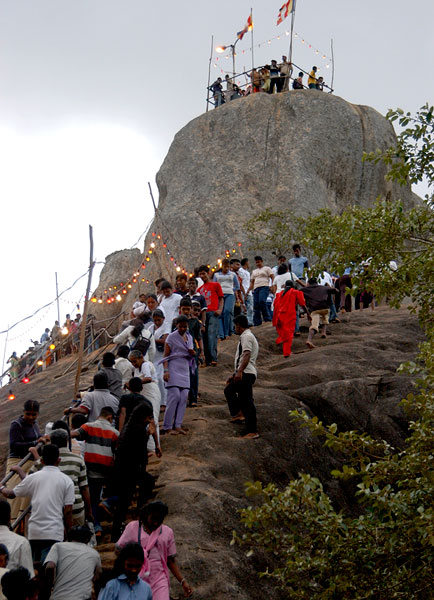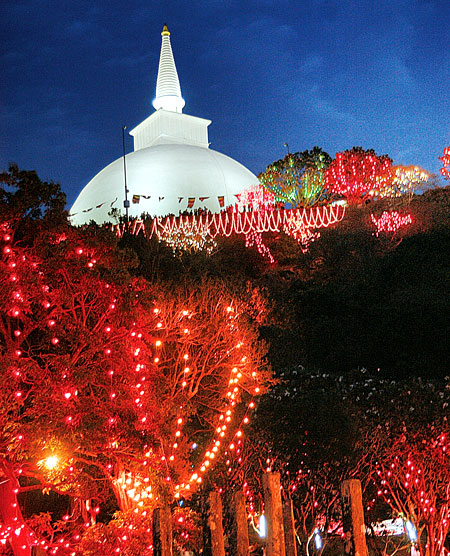|
Poson Poya:
Celebrating a momentous event
 |
|
Devotees climbing the Mihintale rock |
As the arrow went in search of its unseen quarry at lightning speed
in the stillness of the jungles around a massive rock, the ruling
monarch of an island in the Indian Ocean barely heard someone calling
his name. No one dared to call his name - they called him Your Majesty,
prostrating themselves before him. But not this time.
With his soldiers clearing a path ahead of him, the king came out of
the jungle to see who had indeed dared to call him by his first name.
The sight that befell his eyes amazed him. A sage was atop the rock,
beckoning him to come closer. Little did he know at the time, but that
“calling” would change the history of his little island forever.
Then the Arahat uttered those famous words; “Samana Mayan Maharajah
Dhamma Rajassa Savaka Tav’eva Anukampaya Jambudipa Ida Gata”. “Samanas
are we O Great King, the disciples of the King of Truth. Out of
compassion for thee, have we come hither, from Jambudvipa.”
ANCL
Mihintale Aloka Pooja

|
|
The sacred precincts of
Mihintale, the cradle of Buddhism in Sri Lanka, will be
illuminated for the 54th consecutive year by the Associated
Newspapers of Ceylon Limited (ANCL) in collaboration with the
Ceylon Electricity Board (CEB) and several other sponsors
including Dialog, Abans and Bank of Ceylon from June 16 to 22.
The Aloka Pooja program was started in 1963.
Along with the Aloka Pooja,
Lake House will engage in several religious and welfare programs
in and around the Mihintale area for the benefit of residents
and visitors alike. The Aloka Pooja which illuminates the entire
complex in light has been hailed as an immensely beneficial
program for the thousands of pilgrims who flock to Mihintale
during the Poson week. |
He laid his bow and arrow aside, and approaching the sage, he
exchanged greetings with the Thera and sat down near him. The great
Thera caused the others who had come with him to become visible.
When the king beheld these too, he said: “When did these come hither?
The Thera answered: “they came with me. And he asked: “Are there in
Jambudvipa other ascetics like these?
“The other said, “Jambudvipa is gleaming with yellow robes, and great
is the number there of Arahats learned in the Theravadas, gifted with
miraculous powers, skilled in reading the thoughts of others, possessing
the heavenly ear, the disciples of the Buddha.”
The King then asked, “By what way are you come? And since the answer
was: “Neither by land nor by water are we come,” he understood that they
had come through the air.
In the conversation that ensued Arahat Mahinda found that the king
was an intelligent ruler. Therefore he delivered the Cula-Hatthipadopama
Sutta, “The parable of the Elephant Foot Print”, which deals with the
fundamental tenets of Buddhism. At the end of the discourse he, with his
40,000 of his retinue came unto the Three Refuges of the Buddha, Dhamma
and Sangha. Emperor Dharmashoka had achieved his mission.
Today, thousands of years later, these islanders (who now call their
island Sri Lanka) still celebrate this momentous event when those envoys
from India brought India’s greatest gift to their Motherland: the words
of the Buddha. The main envoy, Arahat Mahinda, son of Emperor Dharmasoka,
is revered to this day as “Anubudu” which infers that he is second only
to the Buddha himself. That is the extent of the importance attached to
the arrival of Buddhism in Sri Lanka, whose civilization and culture wee
essentially woven around and shaped by the religion. Incidentally, the
nearby Ambastala Dagaba, enshrines the ashes of Mahinda and is still in
a good state of preservation.
 |
|
Aloka Pooja
(Pix: Sudam Gunasinghe) |
Sri Lanka is one of the few countries where Buddhism exists in its
purest form, not much different from the message conveyed by Arahat
Mahinda. The place where this significant event took place is now known
as Mihintale (literally Mahinda’s rock) and attracts of thousands of
devotees especially on Poson Poya day, which marks the arrival of Buddha
Dhamma in Sri Lanka in the third century B.C. Along with the venerated
sites in nearby Anuradhapura, once the capital of Sri Lanka (and perhaps
the longest surviving place name in the world), Mihintale is on every
Buddhist’s pilgrimage wish list.
The most immediate impact of Buddhism’s arrival in Sri Lanka was the
inception of an order of Bhikkus in the island, which helped propagate
Buddhism to every nook and corner. It also brought peace to an island
that had seen plenty of conflict fuelled by various tribes. The kings
who succeeded King Devanampiyatissa continued to give the foremost place
to Buddhism in all their activities. In paying homage to the Buddha,
they created some of the most astonishing structures and statues that
stand to this day around the country. It would not be incorrect to say
that the entire civilisational fabric of the island is built around the
principles of Buddhism.
In the words of the late Dr. G. P. Malalasekera, “If the criterion of
the greatness of that movement be the beneficial influence it has
exerted on the character on those who came under its sway, then
certainly the mission of Asoka to Lanka has been among the greatest
civilizing influences of the world for it bequeathed to the Sinhalese
people a gentleness of disposition, a love of peace, a nobility and
refinement of character of which neither the ravages of times, nor
centuries of ruthless warfare, nor the insidious attacks of modern
commercialism have succeeded in depriving them.”
Arahat Mahinda’s Lanka mission was a great success. He found in Lanka
a fertile soil to disseminate the sublime teachings of the Buddha. With
royal patronage Buddhism and its related cultural ethos were firmly
established in Sri Lanka.
Over the years, Poson Poya itself has become the second most
important day of the year for Buddhists in Sri Lanka, after Vesak, which
celebrates the Birth, Enlightenment and Passing Away of the Buddha. It
is marked on an almost similar scale, with religious programmes, dansals,
pandals and illuminations. But the core message of Buddhism has never
faded from the collective Lankan consciousness, which is the perhaps the
greatest achievement of Arahat Mahinda.
– (PDS)
|

